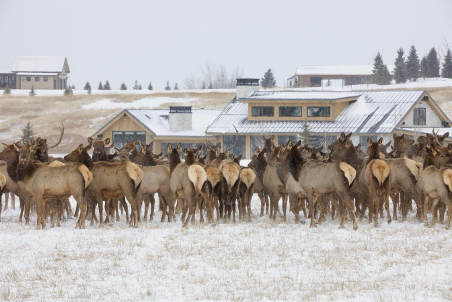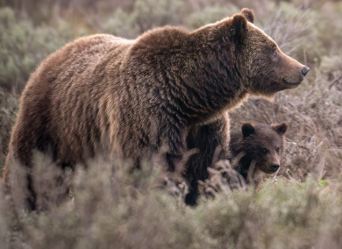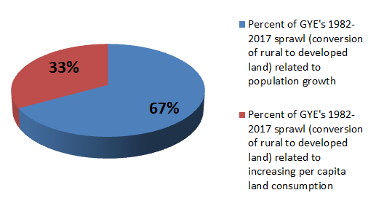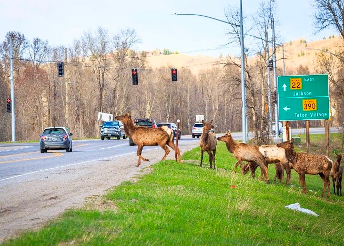Editor’s note: this is an edited version of a longer article by Rob Harding and Leon Kolankiewicz.
From the Everglades to the Arctic, rampant development and a surging human population threaten America’s protected areas. A recent study from NumbersUSA, Greater Yellowstone: An Ecosystem at Risk, documents this for what has been dubbed “America’s Serengeti”: the iconic Greater Yellowstone Ecosystem.
Immigration-driven population growth drives many environmental problems that harm people in the United States, from pollution to crowding to increased traffic. But it’s also a leading cause of habitat degradation and biodiversity loss, as our study and others have found.
Established in 1872, Yellowstone National Park was the very first in the world. While originally set aside for its unrivaled hydrothermal features, Yellowstone has also played a critical role in the survival of such iconic wildlife as the American buffalo, the gray wolf and the grizzly bear.

Bison grazing in Yellowstone National Park. Photo by Leon Kolankiewicz.
Yellowstone preserves some 2.2 million acres of wilderness reaching into three states in the northern Rocky Mountains: Wyoming, Montana, and Idaho. Urban developments such as housing subdivisions and shopping malls are prohibited in this publicly-owned and protected national park. These habitat-destroying incursions are also banned in neighboring national forests and wildlife refuges.
However, privately-owned lands make up about one quarter of the Greater Yellowstone’s Ecosystem’s (GYE) 23 million acres. Most of these private lands are still rural, mostly cultivated farmland and ranchland used for forage production and cattle grazing. These lower-elevation lands are ecologically crucial for the migration and over-wintering of large ungulates such as elk, mule deer, pronghorn, moose and bison. The rugged mountain ranges and high elevations in the Northern Rockies experience deep snow and harsh conditions, which many mammals avoid by migrating to lower lands for the winter months.
Unfortunately, these ancient seasonal pilgrimages and survival strategies in the GYE are now threatened by a booming human population. Development is destroying and fragmenting crucial winter habitat these animals need to survive.

Squeezed out: Wintering elk in Montana’s Gallatin Valley are crowded into fragmented patches of habitat as they lose ground to sprawling residential development. Photo by Holly Pippel.
Increasing human numbers in Greater Yellowstone also increase mortality of wildlife from collisions with vehicles on ever busier roads. Last October, the most famous grizzly bear in the world, Grand Teton National Park’s Grizzly 399, a 28-year old female that was still reproductively active and known to have raised 18 cubs over her lifetime, was fatally struck by a vehicle south of Jackson, WY outside of Grand Teton National Park.
Already the third-most populous country on Earth in 1990 at 250 million, America’s numbers have grown by another 90 million in the ensuing 25 years, primarily due to mass immigration. At the peak of de facto open borders under the Biden Administration, immigration alone added another 3.5 million people in a single year (2023).
Today the United States is pushing 340 million human residents and our population continues to grow with no end in sight. This rapid national growth has propelled a population boom in the Northern Rockies, as Americans flee overcrowded states like California for regions that, until recently, enjoyed low population density and ample “elbow room.” Meanwhile bird, mammal and other animal populations are declining.

Grand Teton National Park Grizzly Bear 399 with one of the known 18 cubs she raised during her 28-year lifetime. Photo by C.J. Adams, National Park Service.
Sprawling development threatens the wildlife of the Greater Yellowstone Ecosystem. Greater Yellowstone: An Ecosystem at Risk quantifies the relative importance of the two main factors driving sprawl and the permanent conversion of rural land to developed land in the GYE. These two main drivers are: 1) population growth, an increase in the number of residents; and 2) growth in per capita land use, an increase in the average developed land per person.
We used data from two federal government agencies: the Natural Resources Conservation Service and the U.S. Census Bureau. We found that the area of developed land in the 20 GYE counties grew from 345,300 acres in 1982 to 497,400 acres in 2017, an increase of 44% or 152,100 acres (237 square miles). 67% of this increase was driven by population growth and 33% by increasing developed land per capita, according to government figures.

Sprawl Factors (Increasing Population and Increasing Per Capita Land Use) in GYE Counties, 1982-2017.
For the most recent 2002-2017 period, the data shows 85% of Greater Yellowstone sprawl was driven by population growth. In other words, almost all of it.
The U.S. Census Bureau projects the population of GYE counties will grow from 540,000 in 2022 to 765,000 by 2060, an increase of 225,000 or 42%. If average population density stays the same, this will lead to the loss of another 232,000 acres (362 square miles) of rural land in the region. This loss will entail significant adverse, long-term effects on biological diversity, particularly for Greater Yellowstone’s large mammals, who will lose critical winter range.

Elk attempt a dangerous road crossing in the Wyoming portion of GYE. Photo credit: Holly Pippel.
Presenting these results to the 16th Biennial Scientific Conference on the Greater Yellowstone Ecosystem late last year, study author Leon Kolankiewicz said:
Avoiding this undesirable outcome will require a combination of 1) effective local planning measures and 2) commitment to national population stabilization. Each is necessary, neither is sufficient in itself, to preserve the unique character and iconic wildlife of the GYE.
The good news is that there is political support among Americans generally and Greater Yellowstone residents in particular for actions to control sprawl at both the local and national levels. This was clearly revealed in the results of polling conducted last summer by Rasmussen Reports and NumbersUSA. Majorities in the GYE supported both local measures such as zoning and urban growth boundaries, and national measures such as reducing immigration to slow national population growth (which in turn drives population growth in the GYE itself).
Reducing immigration-driven population growth is a key to successfully conserving Yellowstone and the other national parks and wildlands that Americans love. By choosing small families, we ourselves have chosen to end the population growth that threatens them. It’s time for our political leaders to choose likewise, by reducing immigration.
Take Action
Your voice counts! Let your Member of Congress know where you stand on immigration issues through the Action Board. Not a NumbersUSA member? Sign up here to get started.
Donate Today!
NumbersUSA is a non-profit, non-partisan organization that relies on your donations to works toward sensible immigration policies. NumbersUSA Education & Research Foundation is recognized by America's Best Charities as one of the top 3% of well-run charities.
Immigration Grade Cards
NumbersUSA provides the only comprehensive immigration grade cards. See how your member of Congress’ rates and find grades going back to the 104th Congress (1995-97).